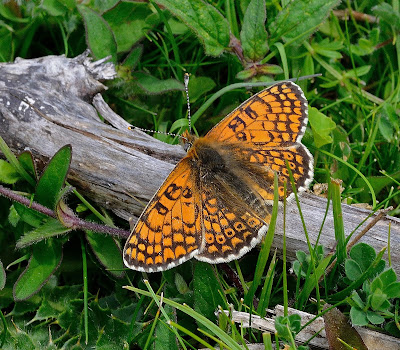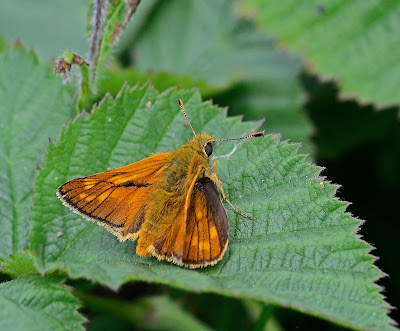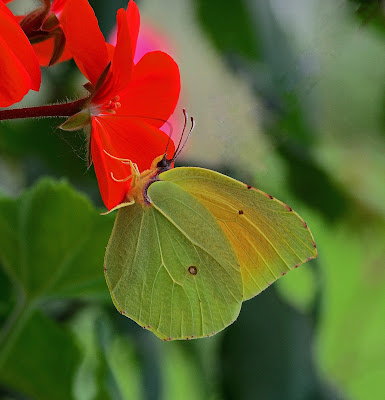Three first of the year sightings were made yesterday.On West High Down the Dark Green Fritillaries are on the wing and flying at great speed,not taking time it seems to stop and settle.Two other sightings were that of a male Small Skipper on the Down and a fresh Gatekeeper in Walters Copse.Other butterflies now becoming numerous are Marbled White and Meadow Brown.
Thursday 7 July 2016
Friday 1 July 2016
Sunshine At Last.
Two target species today were the White Admiral and the Marbled White.The former had already been seen in Bouldnor Forest a few days ago although I was yet to find my first Marbled White of the year.At last the sun was out today following a period of wet and windy weather.However, the wind has not abated and perhaps it had an effect on the butterflies as both species were flighty.Despite seeing several White Admirals none took the opportunity to feed on the abundant bamble flowers in the forest.The two Marbled Whites I encountered were just as jittery and I was lucky to catch any at rest.
Happily the Silver-washed Fritillaries were more accommodating and I managed to get good views of these handsome woodland butterflies.This included my first female of this summer seen basking in a sunny glade
.
Saturday 25 June 2016
Back to Bouldnor.
Following the brief sighting of a Silver-washed Fritillary at Bouldnor Forest yesterday, I decided to have another attempt to get a better look at this butterfly today.Things did not look good as shortly after I arrived it started to rain.This has been the way of the weather recently with regular thunderstorms.Eventually the rain stopped and blue sky appeared.It was not to last long, but just long enough for the sun to shine and tempt out some butterflies.Several Silver-washed Fritillaries made for the bamble flowers as did a White Admiral which is a first sighting of the year.
Friday 24 June 2016
More First Sightings.
The weather continues to remain unsettled and today on the Isle of Wight it was generally cloudy with brief sunny spells and a brisk wind. So perhaps the best place to minimise the effects of that wind was to visit my local forest at Bouldnor.When the sun did appear one or two butterflies took to the wing and I was happy to see my first Silver-washed Fritillary of the season.He was feeding on the ample bramble flowers that are in the forest now, but unfortunately for me he decided to disappear over the hedge and was not to be seen again.However another first of the year was not too far away, for close by a male Ringlet fluttered around hoping to find a good basking place.Along the forest tracks were good numbers of Meadow Brown nectaring on the bramble flowers.
Monday 13 June 2016
Under The Olive Trees.
Find an olive grove carpeted in wildflowers on any Greek Island and it is certain that a good selection of butterflies will be encountered.The mix of butterflies may depend on the altitude, and the particular spot I came across on Lefkada recently was at sea level.The dominant species were Common Blue along with a favourite of mine, the Clouded Yellow.Other butterflies included Small Copper,Meadow Brown,Brown Argus,Painted Lady,and various Whites.The dark Small Copper below is apparently a form commonly seen in Greece.




Friday 10 June 2016
Up To West High Down.
At this time in the season a walk up to West High Down via a bridleway can be a chance to see the first Dark Green Fritillaries of the year.There was a report of two Dark Greens on nearby Brook Down a few days ago.However despite my best efforts none was in evidence today.
The bridleway that leads to the Down is sided by brambles and bushes to the north and more open ground to the south which perhaps are old quarry workings.Here, plenty of chalk downland plants grow and bloom which attracts a variety of butterflies due too to its sheltered aspect.The most common species today were Common Blue and Brown Argus although I was surprised to see a pristine Glanville Fritillary.It is somewhat out of its usual area which is a short way down the coast but they do get around and can turn up quite a way inland.As on the Down, there were good numbers of Large Skippers and I also came across a Small Tortoiseshell uploading salts from the track.
Thursday 9 June 2016
Villa Garden Visitors.
Although butterfly friendly plants were very limited in the extensive garden of our holiday villa on the Greek Island of Lefkada last week, up to fifteen species were noted either in the garden or passing through it.Fortunately the grounds were sided by olive groves and pasture pens,both with a profusion of wildflowers so there was plenty to interest the butterflies.
The villas vast lawn had patches of clover which attracted Long-tailed Blues and Common Blues while a large fig tree at the front housed a couple of Lattice Browns and Speckled Woods.The former nectared from any damaged half ripe fruits while the Speckled Woods competed for the dappled sunny spots around the base of the tree.A small honeysuckle plant on the porch was favoured by a Southern White Admiral and the magnificent flowering geraniums along the length of the rear veranda were visited by Cleopatra's as well as that Geranium Bronze already mentioned in the previous blog entry.
Tuesday 7 June 2016
Pelargonium Princess.
Or sometimes Pelargonium Pest as the Geranium Bronze butterfly is native of South Africa and has an attraction to this plant either cultivated or wild.It is the only food plant of Cacyreus marshalli and was thought to have been accidentally imported to Europe on geraniums in the late 1980's.Since then it has spread and a few years ago was recorded on the Greek Island of Corfu.Well now it has progressed to Lefkada somewhat south of Corfu as I witnessed last week when I observed a female egg laying in the garden of our holiday villa.
Wednesday 18 May 2016
Pearly Kings and Queens.
The Pearl-bordered Fritillary is no longer found on the Isle of Wight.Perhaps the nearest site to see these lovely butterflies is the New Forest in Hampshire which is a short ferry ride across the Solent.
Yesterday we made the trip despite mainly cloudy and breezy conditions.However the sun did appear at intervals which encouraged the butterflies into some activity.Here in the Forest these Fritillaries seem to thrive due to sympathectic woodland management which unfortunately is completely lacking in their former Island site of Parkhusrt Forest.
| New Forest Pearl-bordered Fritillary Habitat. |
Friday 13 May 2016
Orange Tips at Walters Copse.
It was a sultry afternoon at Walters Copse yesterday.Fortunately the thunderstorms had not yet rumbled by and I was treated to some hazy sunshine.Earlier in nearby fields I had heard my first cuckoo of the year and also a nightingale from the hedgerows.
In the copse there were plenty of Orange Tips to see and several females fluttered around the Lady's Smock or cuckooflower as it commonly known.Named of course for the plants flowering time which coincides with the arrival of the first cuckoo.This is a primary larval plant of the Orange Tip so it is a usual sight to see the females laying their single egg on it.For both the male and female it is a favourite nectaring flower.




Subscribe to:
Posts (Atom)











































